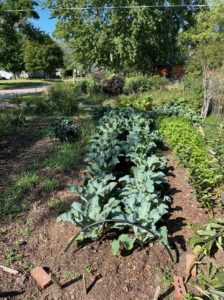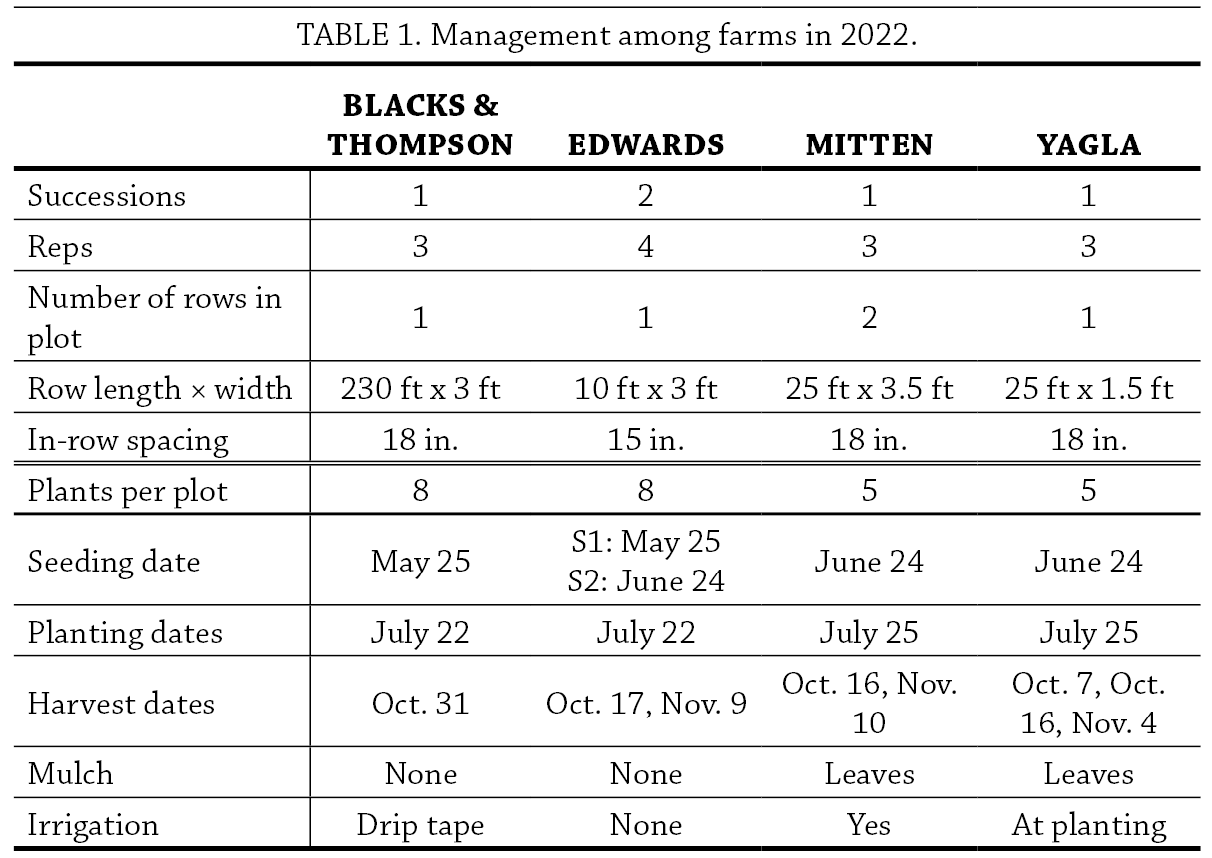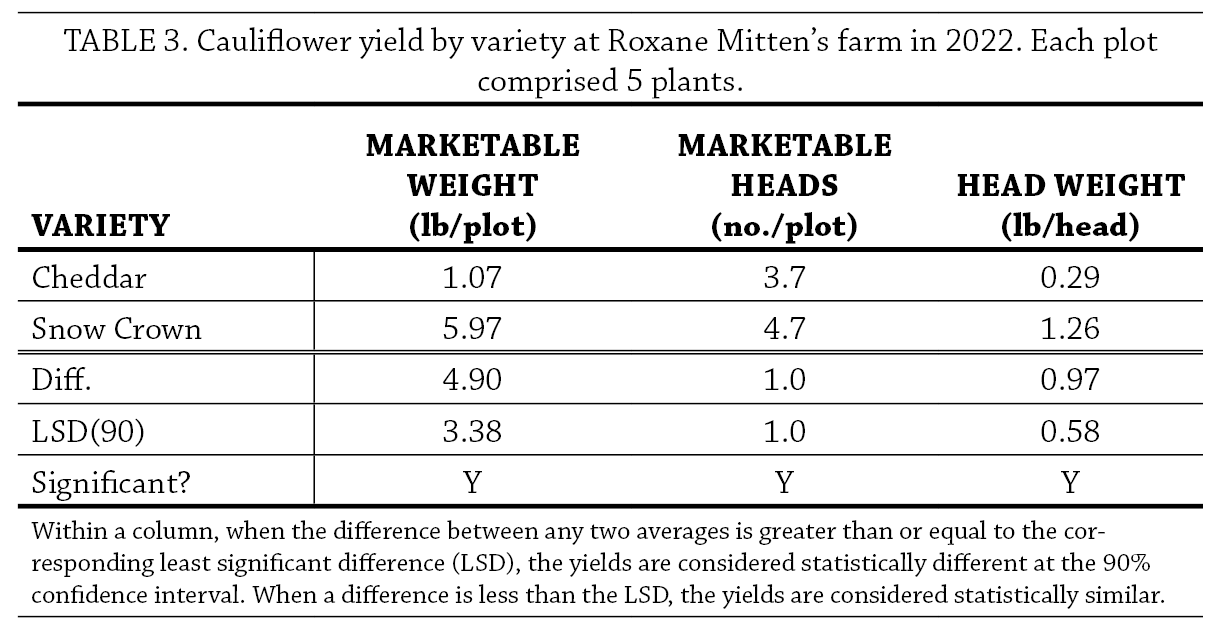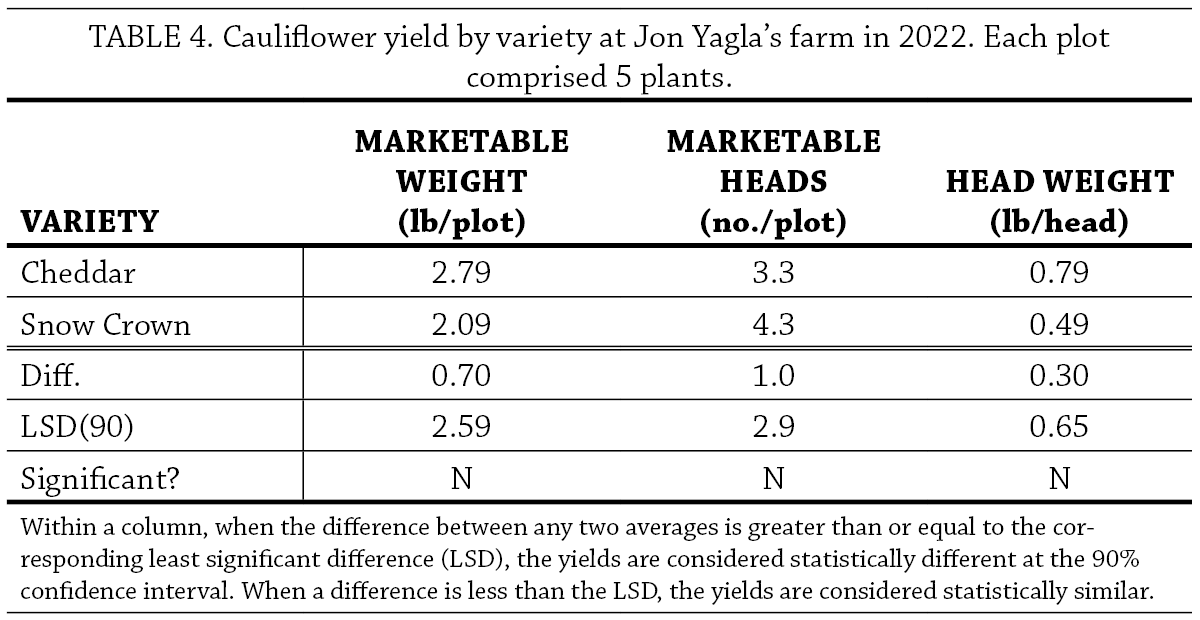In a Nutshell:
- Kate Edwards, Carmen & Maja Black and Helaina Thompson, Jon Yagla and Roxane Mitten wanted to find a cauliflower cultivar which can consistently produce a fall crop.
- They trialed five cauliflower varieties and hypothesized that the cultivar with the shortest days to maturity (Snow Crown, 50 days) would be the most successful.
Key Findings:
- Snow Crown outperformed the other cultivars on all cooperator farms except at Yagla’s.
- At Edwards’ farm, the earlier succession of cauliflower planting yielded higher than the second succession.
Background
High quality fall cauliflower is in demand among CSA customers, but growers find it challenging to produce consistently each year. Iowa’s hot and humid summers provide perfect conditions for black rot – a pervasive bacterial disease, to flourish; and excessive heat during the period of head formation delays development such that the first fall frost sometimes strikes before heads have sufficiently matured.[1,2] A team of eastern Iowa farmer-researchers led by Carmen & Maja Black, Helaina Thompson, Kate Edwards, Roxane Mitten and Jon Yagla designed a trial to determine which of the following cauliflower varieties ranging in number of days to maturity would yield best in their operations:
- Snow Crown (50 days to maturity)
- Cheddar (58 days to maturity)
- Flame Star (62 days to maturity)
- Amazing (68 days to maturity)
- Lavender (70 days to maturity)
They hypothesized cauliflower with the fewest number of days to maturity would yield greatest. Fewer days to maturity means a shorter growing period, which could minimize opportunity for the black rot pathogen to infect and cause disease as well as decrease the odds of a fall frost striking before cauliflower fully mature. The growers also planted cauliflower in two different successions to shed light on whether or not they should consider adjusting their planting dates.
This research includes two varieties that were tested by Mark Quee (Scattergood Farm) and Shanti Sellz (Muddy Miss Farm) in a 2019 variety trial – Snow Crown and Amazing.[3] At Sellz’s, Snow Crown was the only variety out of four to generate any yield, but only in the second of her two succession plantings. Quee fared better. Amazing was competitive but not the leader in his first succession, and no varieties stood out as better or worse in his second succession.
Methods
Design
Two of the cooperators, Mitten and Yagla, compared two cauliflower cultivars, Snow Crown and Cheddar, in a randomized complete block design with three replications. The other two cooperators, Blacks & Thompson and Edwards, compared five cauliflower cultivars (Amazing, Cheddar, Flame Star, Lavender and Snow Crown) in a randomized complete block design with four replications. Edwards also compared the five cultivars in two successional plantings (4 cultivars x 4 replications x 2 successions= 32 plots). Management details are presented in Table 1.
Measurements
At each harvest the cooperators recorded the number and weight of marketable cauliflower heads from each cultivar. Incidence of black rot in cauliflower heads was noted. Yagla and Mitten also recorded the date of first head formation of the two cultivars compared on their farms.
Data analysis
To determine the difference in cauliflower yield between cultivars at Blacks & Thompson’s, Mitten’s and Yagla’s, we analyzed the number and weight of marketable heads using the least significant difference (LSD) generated from a t-test. At Edwards’, we used Tukey’s LSD in order to make comparisons among the five cultivars trialed. With either analysis (t-test or Tukey’s), if the difference in cauliflower yield between any two cultivars was greater than or equal to the LSD, the cultivars are considered to be significantly different. Using a 90% confidence level, growers could expect this outcome 9 out of 10 times under the same conditions. The statistical calculations could be made because all growers used randomization and replication of their treatments in their experimental designs (Figure A1).
Results and Discussion
Yield
At the Blacks & Thompson’s, only Snow Crown and Cheddar produced marketable heads. The remaining three cultivars (Amazing, Flame Star and Lavender) did not produce any marketable heads and, therefore, do not have results to present. Snow Crown yielded a significantly higher weight of marketable heads per plot than Cheddar (Table 2). The two cultivars produced a similar number of marketable heads. Snow Crown produced larger marketable heads on average, contributing to the overall higher weight per plot.
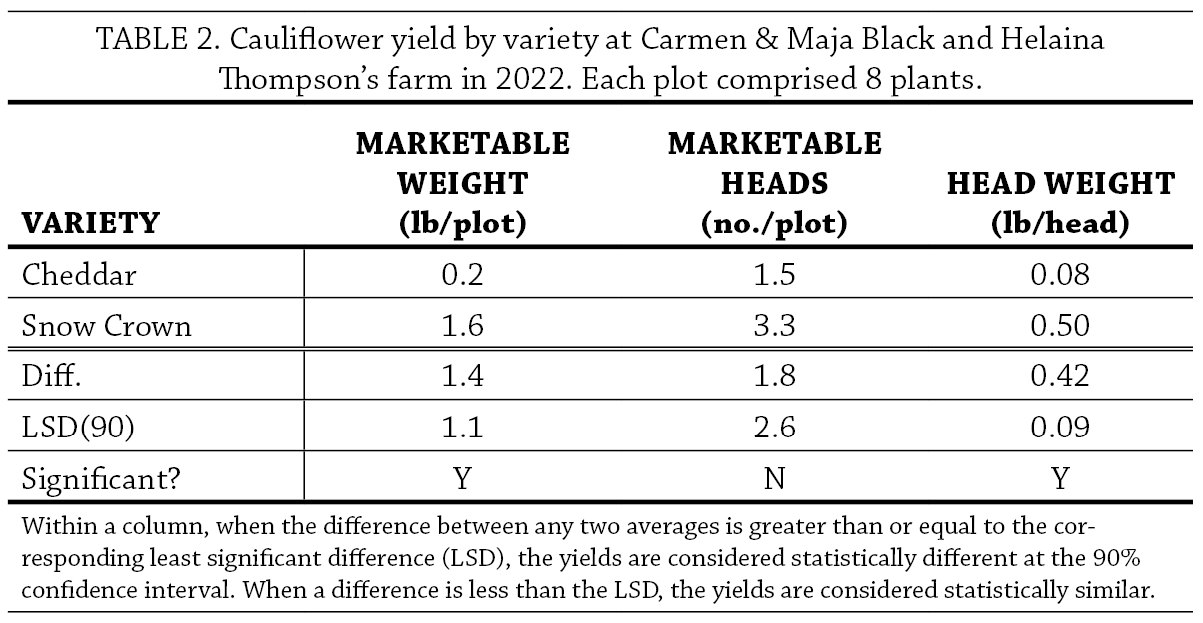
At Mitten’s, Snow Crown produced a significantly higher number and weight of marketable heads per plot (Table 3). Snow Crown also produced a significantly larger average head weight.
No significant differences were found in the number and weight of marketable heads between Snow Crown and Cheddar at Yagla’s (Table 4). The two cultivars also produced similar average head weights.
Edwards trialed all five varieties in two successions. Regardless of variety, the first succession produced significantly more weight per plot and more marketable heads than the second succession (Table 5). The average head weight in both successions, however, was not different.
When considering the effects of variety at Edwards’, similar patterns emerged in both successions so results from both successions were combined. Snow Crown was generally the top producer among the five cultivars while Amazing and Flame Star were generally the least productive. Cheddar and Lavender were somewhat intermediate in terms of the number of marketable heads and head weight.
Figure 1 illustrates that Snow Crown produced three times more marketable weight per plot than the four other varieties. The other four varieties (Cheddar, Lavender, Amazing and Flame Star) were statistically similar in terms of marketable weight per plot; on average they each produced 1.6 lb/plot while Snow Crown produced 5.3 lb/plot.
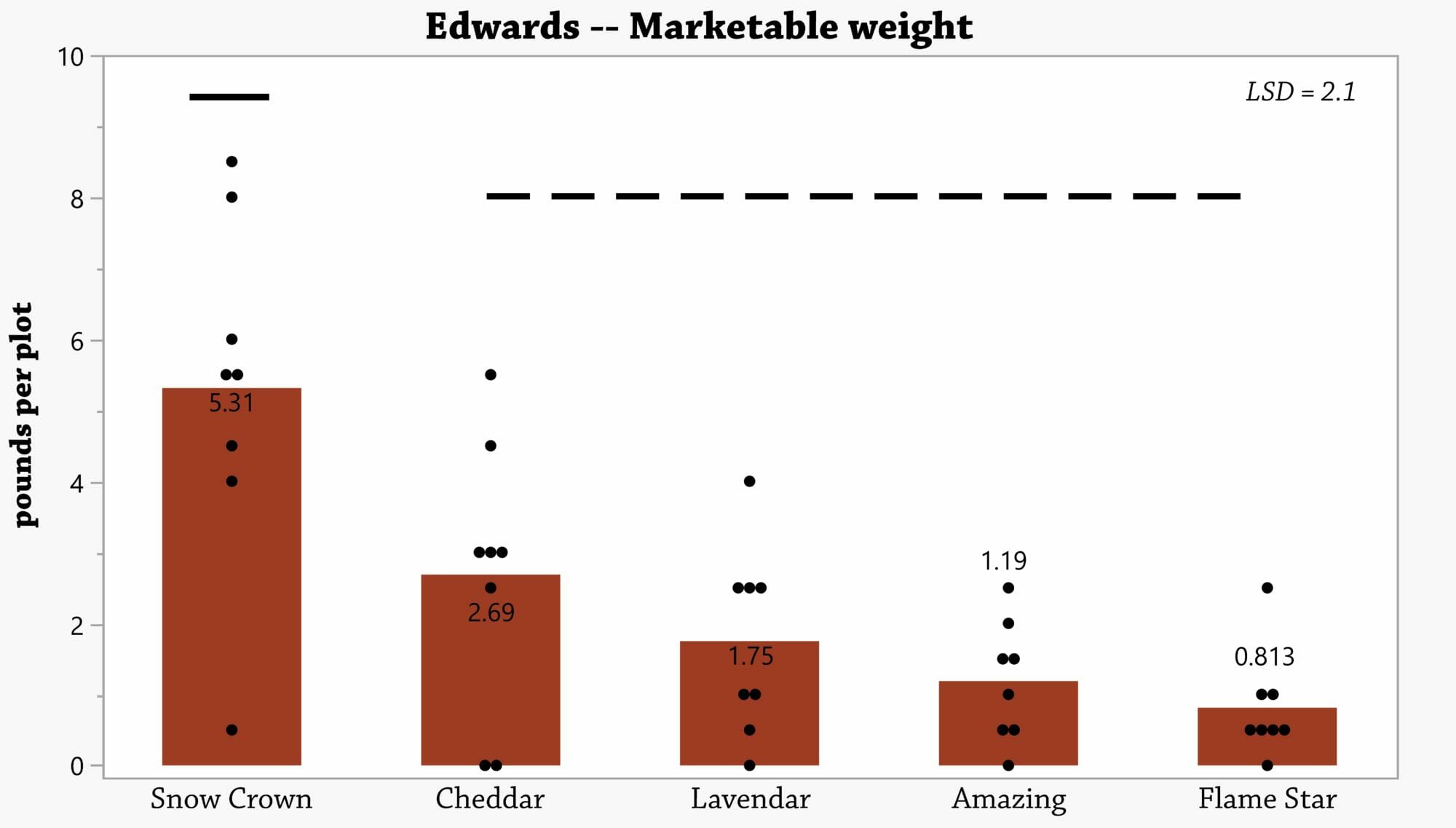
FIGURE 1. Marketable weight of cauliflower per plot across both successions at Kate Edwards’ farm in 2022. Columns represent the average weight per plot produced by each variety. Points represent the weight produced from each individual plot for each variety. Values in or above the column are the average for each variety. Values that differed by more than the least significant difference (LSD = 2.1 lb/plot) are considered statistically different at the 90% confidence level. Solid horizontal line indicates Snow Crown was statistically greater than all other varieties. Dashed horizontal line indicates four varieties that were statistically similar to one another and statistically less than Snow Crown.
In terms of marketable heads produced per plot, Snow Crown was tops (5.6 heads/plot) but not alone (Figure 2). The number of marketable heads produced per plot by Cheddar (3.9 heads/plot) and Lavender (3.0 heads/plot) were enough to be statistically similar to Snow Crown. Cheddar and Lavender, however, were also statistically similar to Amazing (2.4 heads/plot) and Flame Star (1.8 heads/plot). These overlapping statistical similarities are depicted by the solid and dashed lines appearing above the columns in Figure 2. When interpreting these results, it is probably also worth noting the results from each individual plot for each variety. This is depicted by the points among the columns in Figure 2. From the points for each variety, we can get a sense of the variation within the variety but also the fact that some plots for some varieties resulted in no heads harvested (0 heads/plot). Two Cheddar plots did not produce any heads and one plot from each of Lavender, Amazing and Flame Star did not produce any heads. Meanwhile, there were no instances in which Snow Crown did not produce heads. These details are probably important when interpreting these results and selecting a variety to grow on the farm.
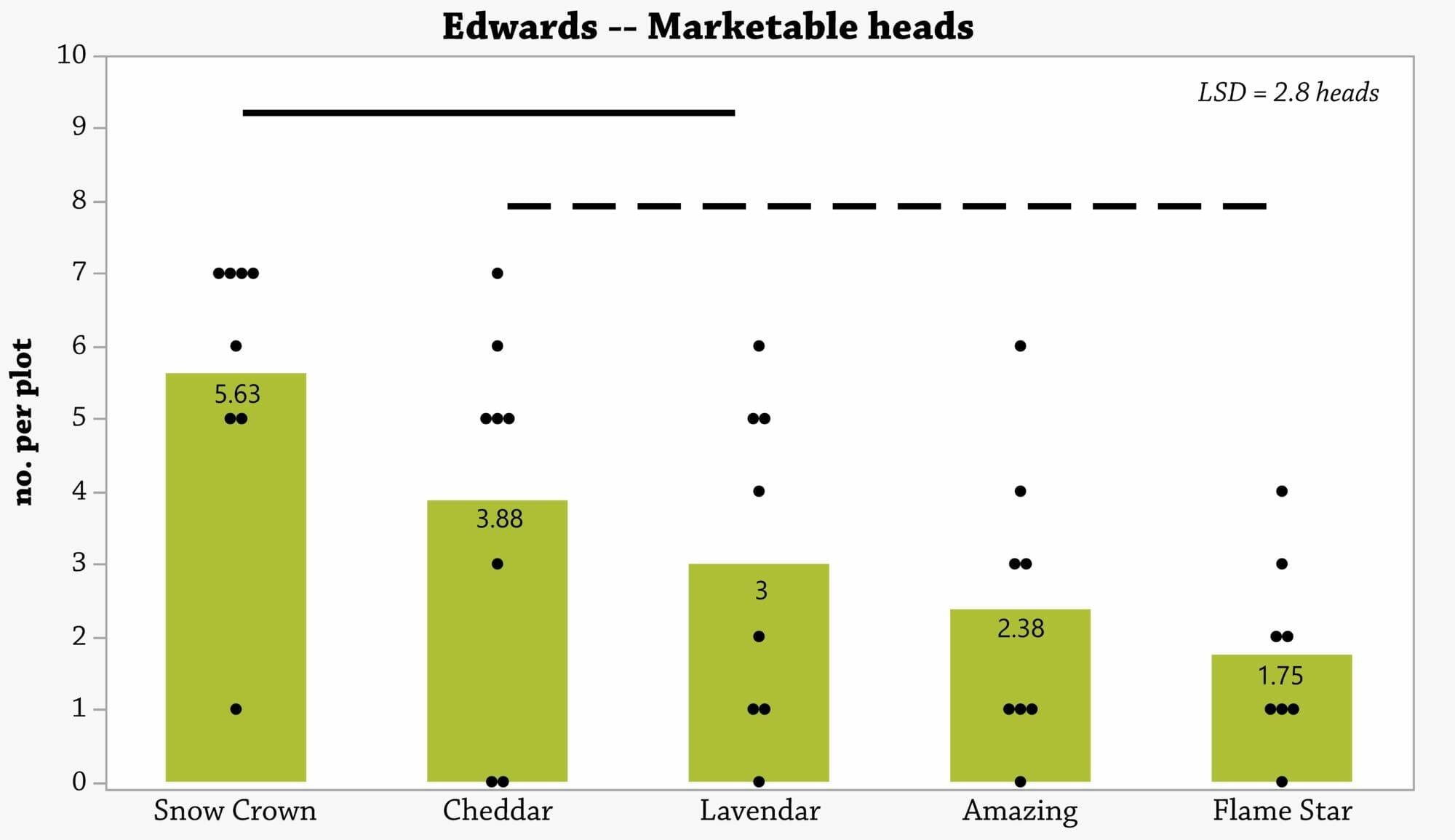
FIGURE 2. Number of marketable cauliflower heads per plot across both successions at Kate Edwards’ farm in 2022. Columns represent the average number of heads per plot produced by each variety. Points represent the number of heads produced from each individual plot for each variety. Values in the column are the average for each variety. Values that differed by more than the least significant difference (LSD = 2.8 heads/plot) are considered statistically different at the 90% confidence level. Solid horizontal line indicates Snow Crown, Cheddar and Lavender were statistically similar to one another. Dashed horizontal line indicates Cheddar, Lavender, Amazing and Flame Star were statistically similar to one another.
Snow Crown produced the largest heads (0.91 lb/head) but was not alone in this distinction statistically (Figure 3). Heads produced by Cheddar (0.72 lb/head) and Lavender (0.61 lb/head) were statistically similar to those produced by Snow Crown. But just as with the number of heads produced per plot, Cheddar and Lavender heads were also statistically similar to those of Amazing (0.56 lb/head) and Flame Star (0.51 lb/plot). Important to note here is that only plots which produced heads were considered for this analysis. Recall that some Cheddar, Lavender, Amazing and Flame Star plots failed to produce any heads (Figure 2).
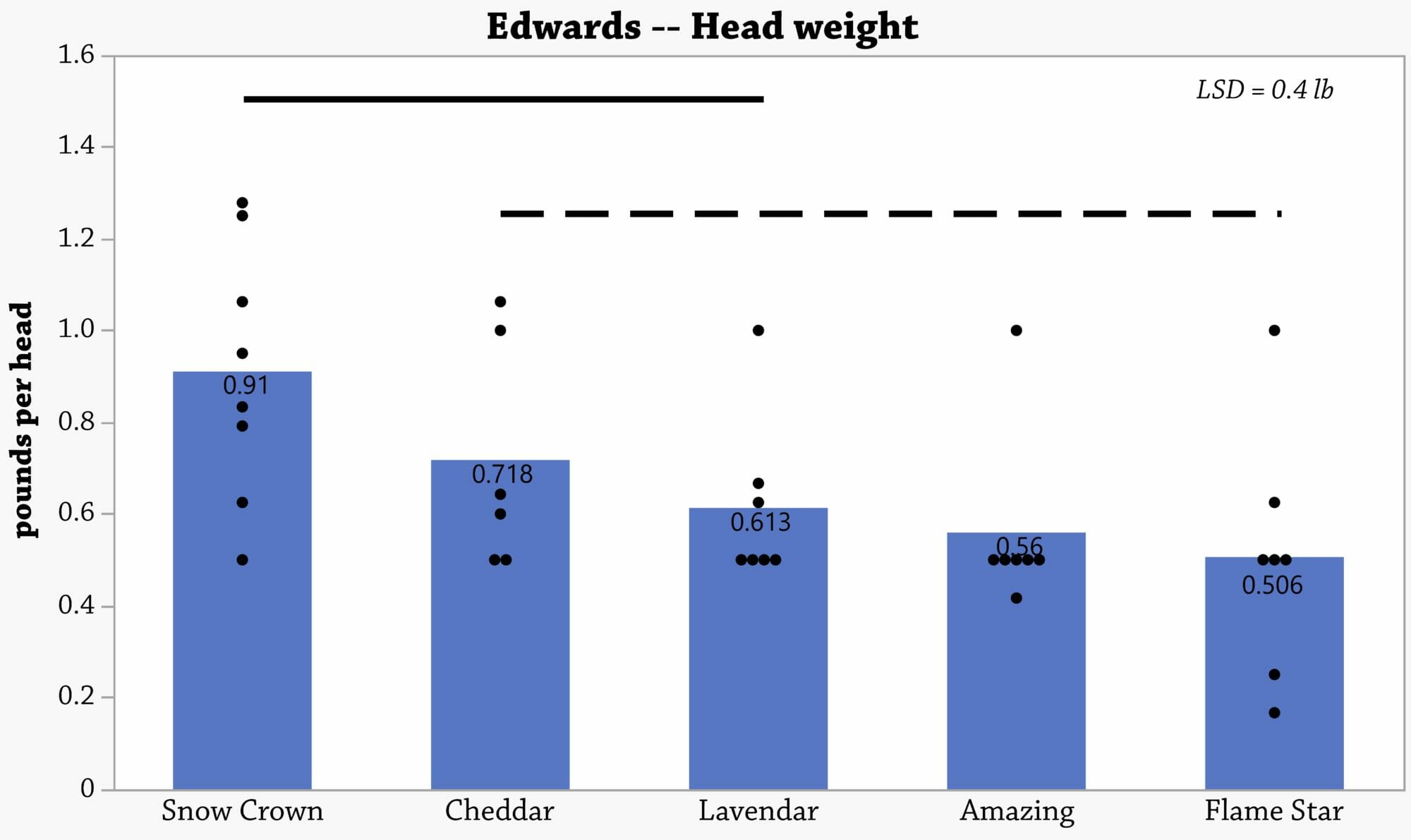
FIGURE 3. Head weight of cauliflower across both successions at Kate Edwards’ farm in 2022. Columns represent the average head weight produced by each variety. Points represent the weight of heads produced from each individual plot for each variety. Values in the column are the average for each variety. Values that differed by more than the least significant difference (LSD = 0.4 lb/head) are considered statistically different at the 90% confidence level. Solid horizontal line indicates Snow Crown, Cheddar and Lavender were statistically similar to one another. Dashed horizontal line indicates Cheddar, Lavender, Amazing and Flame Star were statistically similar to one another.
Taken together, it is safe to consider Snow Crown as the top performer at Edwards’. Because Snow Crown ranked at the top for both number of heads produced per plot (Figure 2) and head weight (Figure 3), and because no Snow Crown plots failed to produce any heads (Figure 2), this translated to Snow Crown producing the most marketable weight per plot (Figure 1).
Head formation
Both Mitten and Yagla observed head formation earlier in Snow Crown than in Cheddar. Mitten’s Snow Crown began forming heads 36 days before Cheddar, Snow Crown on Sept. 12 and Cheddar on Oct. 18. Yagla’s Snow Crown began forming heads 17 days before Cheddar, Snow Crown on Sept. 23 and Cheddar on Oct. 10.
Black rot
Yagla noted a few Cheddar cauliflower plants with potential black rot symptoms. None of the other cooperators found incidence of black rot on the cauliflower heads of any variety.
Days to maturity
When considering the results from all farms, Edwards reflected on the stated days to maturity for each variety trialed. “We should have been able to harvest from each variety based on our planting dates, harvest dates and the days to maturity stated for each variety,” Edwards said. “But for a summer-sown and fall-harvested crop, days to maturity stated in the seed catalog may not apply.” In other words, because temperatures begin to cool (rather than heat up) in the fall, there is a chance that cauliflower maturity might be delayed (or completely precluded) if temperatures cooled too quickly before a killing frost. As such, we took a look at the number of growing degree-days (base=40°F) accumulated between July 22–Nov. 10 (the earliest and latest planting and harvest dates across farms) for the Iowa City area in 2022 and compared this with the 50-year average.[4]
- 2022: 2,642
- 50-yr: 2,722
The growing period experienced 80 less growing-degree days in 2022 than the long-term average. Had the farms experienced more normal summer–fall temperatures or if the farmers planted cauliflower a couple of weeks earlier, they may have observed better performance from some of the later maturing cauliflower varieties trialed..
Conclusions and Next Steps
Of the cultivars evaluated, Snow Crown seems to be the variety best suited to fall cauliflower production in Iowa, producing larger heads and higher marketable weights among most cooperator farms. Carmen Black said, “we will definitely be planting Snow Crown again” as “it will yield heads when planted late and in a drought.” Black and Edwards found satisfaction in the trial and plan to implement changes on their farms, hopefully better able to maximize row footage by only growing cauliflower which can be harvested and sold. Edwards added, “I need to plant the other varieties much earlier to be successful with them.” Snow Crown has the shortest days to maturity of the cultivars evaluated, allowing it to produce marketable heads before consistent hard frost. Edwards was also surprised by the hardiness of Snow Crown, surviving “a few nights of 22 degrees F weather” in October. Mitten also experienced frost hardiness of Snow Crown and Cheddar and attributes higher yield due to the additional 3 weeks of extended fall after a period of hard frosts in October. She suggests that a minor intervention such as a row cover could help production through a frost period in fall to gain a harvest that might otherwise be lost.
All cooperators were interested in working together to better understand the potential for cauliflower in Iowa, often not given much attention but with appeal to consumers in the late season. Edwards explained that “the trial confirmed that it is a tricky crop and gave us a direction to go in for the future.” Edwards hopes to repeat the trial with earlier planting dates adding that she was “intrigued by how beautiful the orange and purple varieties were and how they didn’t show much disease. I am curious if that will hold true if they are started earlier in the summer.”
Acknowledgements
We wish to extend our gratitude to Johnny’s Selected Seed (Winslow, ME) for donating seed for all varieties trialed in this on-farm research project.
Appendix – Trial Design and Weather Conditions
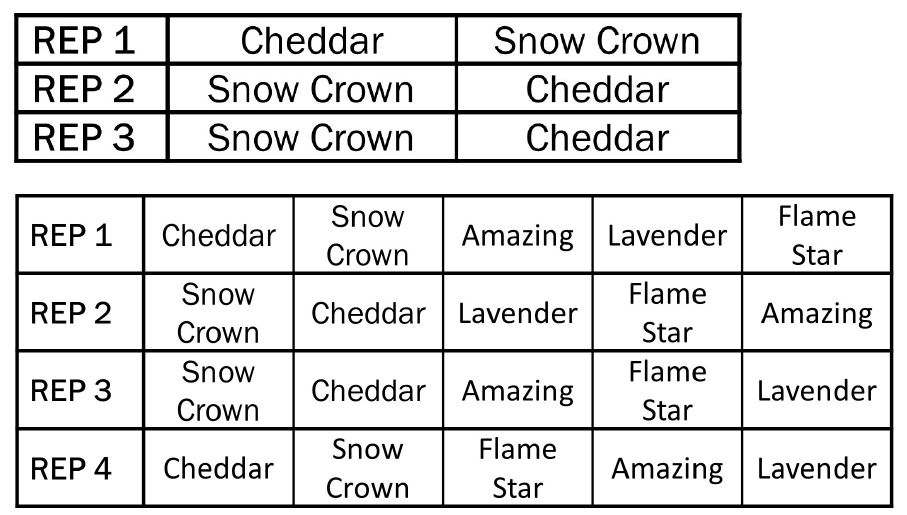
FIGURE A1. Example of experimental designs used by Mitten and Yagla (top) and the Blacks & Thompson and Edwards (bottom). These designs allowed for statistical analysis of the results.
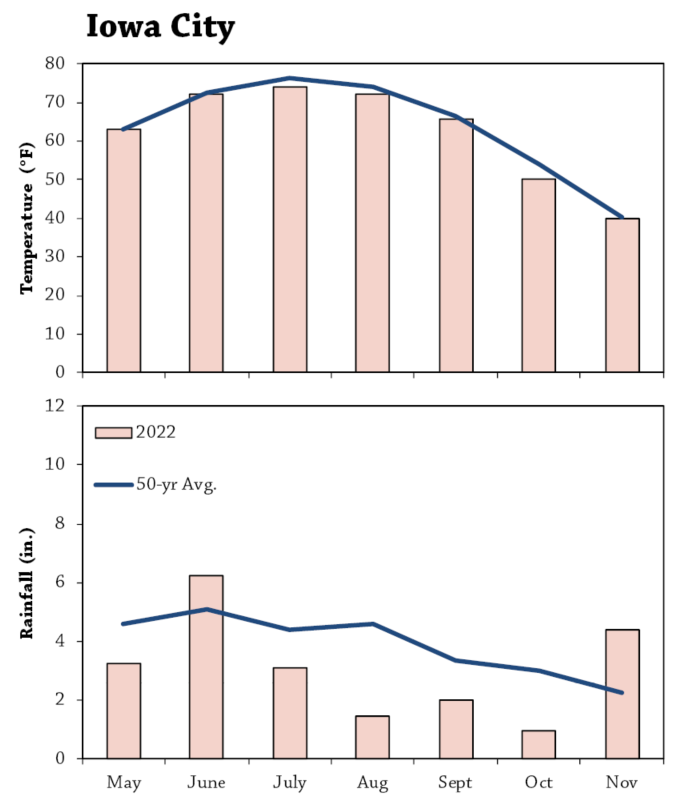
FIGURE A2. Mean monthly temperature and rainfall during the study period and the long-term averages at Iowa City, the nearest weather stations to all farms.[4]
References
1. Hoidal, N. 2022. Black rot of Brassica crops. University of Minnesota Extension. https://extension.umn.edu/disease-management/organic-management-black-rot (accessed December 2022).
2. Cebula, S., A. Kalisz and E. Kunicki. 2005. The course of growth and yielding of white and green cauliflower cultivated in two terms for autumn production. Folia Horticulturae. 17:23–35. https://www.researchgate.net/publication/259975205 (accessed December 2022).
3. Kolbe, L., M. Quee and S. Sellz. 2020. Cauliflower Variety Trial. Practical Farmers of Iowa Cooperators’ Program. https://practicalfarmers.org/research/cauliflower-variety-trial/ (accessed December 2022).
4. Iowa Environmental Mesonet. 2022. IEM “Climodat” Reports. Iowa State University Department of Agronomy. https://mesonet.agron.iastate.edu/climodat/ (accessed December 2022).



